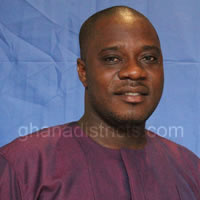Introduction
Chapter six focuses on persons with disability (PWD) in the Kwahu East District with regard to their sex, age, locality of residence, type of disability and activity status.
Population with Disability
Table 6.1 shows the distribution of PWDs by type of locality, disability type and sex. The data shows that 5.3 percent of the population in the Kwahu East District have one form of disability or the other. It also shows that there are more females with disabilities (5.7%) than males (4.8%). The percentage of PWDs as a proportion of the total urban population is 6.3 percent, while the proportion is 4.8 percent for the rural population.
Type of Disability
Figure 6.1 depicts the distribution of disability types in the District. The information reveals that visual impairment is the most common type of disability among PWDs (34.3%), followed by emotional disability (27.3%) and physical impairments (26.5%). Significant proportions of PWDs also suffer from hearing impairments (14.4%), intellectual disability (12.2%) and speech impairment (11.2%).
Distribution of disability type by locality
Figure 6.2 shows that visual or sight, physical and emotional impairments are e the most common types of disability among PWDs in both urban and rural areas in the district even though variations exist between the two locality types. The proportion of PWDs with sight, hearing, speech and intellect impairments is higher in rural areas than urban. However, the percentage of PWDs with emotional challenge is higher in urban than rural areas while there is equal proportion of PWDs with physical challenge in both urban and rural areas.
Disability and Economic Status
Table 6.2 shows that PWDs who are employed in the district constitute 68.8 percent, unemployed 2.6 percent while the economically not active persons form 28.6 percent. This simply means that in the district more than 60 percent (68.8%) of all persons with a disability are employed. The table also indicates that in the district, of the persons with emotional disability, 58.4 percent are employed while 5.2 percent are unemployed. Of persons with intellectual disability, 34.1 percent are employed and 62.5 percent are economically not active in the district, which means that more than half of persons with intellectual disability are economically not active.
With the sexes, a total of 71.1 percent males with disability are employed, while just 2.4 percent are unemployed with 26.5 being economically not active. For persons with sight disability 64.1 percent are employed and emotional disability 5.6 percent. For persons with intellectual disability 55.7 percent are economically not active.
Table 6.3 indicates that 66.8 females with a form of disability or the other is employed and 2.8 percent are unemployed with about 30.4 percent (30.4%) being economically not active. Persons with other forms of disability, 62.6 percent are employed, with 5.0 percent with emotional disability being unemployed. Intellectual disability accounts for 68.8 percent of those economically not active. Just a little over one percent (1.2%) with sight disability are unemployed in the district.
Disability, education and literacy
The table indicates that in the district 20.1 percent of all persons with a form of disability have never been to school and 9.2 are in pre-primary and finally 60.6 basic education with 10.2 with SHS/higher level of education. In the district persons with hearing disability, 47.8 percent have never been to school, intellectual disability 4.4 percent have pre-primary, and other forms of disability 64.3 percent. Of persons with SHS/higher education, emotional disability accounts for 10.3 percent having SHS/ and higher education.
Males with speech disability, 39.6 percent have never been to school, emotional 5.2 percent with pre-primary education while persons with other forms of disability 69.7 percent have Basic education and for persons at the SHS/ higher, 13.3 have physical disability. Persons with hearing disability, 2.1 percent are in pre-primary and for speech it is 7.7 for SHS/Higher education.
The table shows that females with all forms of disability, 24.7 percent have never been to school, 8.9 percent have pre-primary and 58.6 percent are at the Basic level with just 7.8 percent with SHS or higher education. Persons with hearing disability, 59.9 percent have never attended school and those with speech 5.8 percent are at the pre-primary level. The table further shows that for persons with other forms of disability, 59.2 percent are with basic education and at the higher level emotional disability is 8.7 percent. For persons with hearing disability, 3.1 percent have SHS or higher education in the district.
Date Created : 11/26/2017 10:24:37 AM






 facebook
facebook X (twitter)
X (twitter) Youtube
Youtube +233 593 831 280
+233 593 831 280 0800 430 430
0800 430 430 GPS: GE-231-4383
GPS: GE-231-4383 info@ghanadistricts.com
info@ghanadistricts.com Box GP1044, Accra, Ghana
Box GP1044, Accra, Ghana